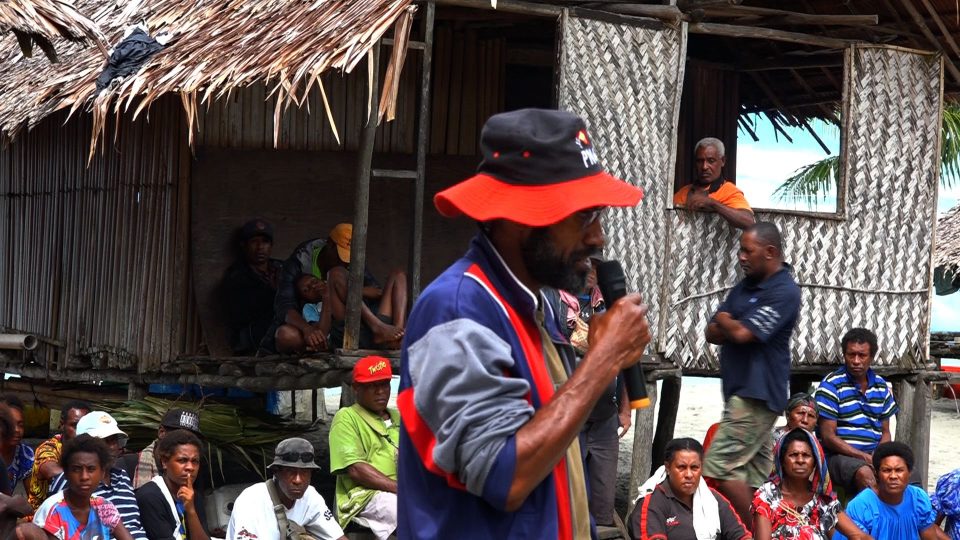The Papua New Guinea’s environment minister has tried to ease tensions over the proposal to dump mine waste into the Huon Gulf in the Morobe Province.
Wera Mori, says they haven’t yet decided if tailings from the USD5 billion Wafi-Golpu project will be disposed using the deep sea tailing placement (DSTP) method. But he has also admitted that the construction of a tailings dam is not part of the plan.
“We have not decided yet. As minister, I have to be satisfied that the operation will be safe.”
Last week, Wera Mori and Officers from the Conservation and Environment Protection Authority (CEPA) visited at least two coastal villages in the Huon Gulf District in a series of consultation meetings with the people.
The meetings have brought to light uncertainties and serious concerns over environmental damage.
“The men can say yes. But for me as a woman, I see a lot of problems ahead,” says Giwi Afio, one of the many women from Asini village along the Salamua Coast.
The meetings are reminiscent of a similar process that happened a decade ago in Madang Province when the government tried to convince Raicoast villagers to accept the dumping of mine waste by the Chinese owned Ramu Nickel Mine.
This eventually led to protests and a lengthy court battle which was eventually withdrawn by the landowners. Back then, the government had already made a decision and it followed a checklist to ensure consultation appeared to happen.
Despite, a petition of signed by more than 7000 villagers, approval was given to proceed with the DSTP option.
In October 2019, more than 200,000 liters of toxic slurry spilled from the processing plant into the Basamuk bay. The government ordered the closure of the plant and CEPA sent officers to investigate the cause.
Government officers are delivering a specific narrative to Morobeans when discussing the Basamuk spill in Madang and the potential risks posed to coastal communities.
Minister Wera Mori has specifically said the Basamuk spill was due to a plant failure and not the failure of the DSTP system.
Morobe’s Large Lutheran population also plays into the dynamics of this push to extend the people’s voice. The Lutheran Church has expressed that the environment needs to be protected.
Lutheran Bishop, Dr. Jack Urame, has been echoing a call for strong environment stewardship – a call also made by his predecessor and environmental campaigner, Bishop Wesley Kigasung who passed away in 2008.
The Lutheran voice is important both in this discussion and in the political discourse of its congregations in Morobe.
The government on the other hand sees this project as a huge catalyst for change and an economic savior, not just for Morobe, but for the rest of Papua New Guinea.
The Papua New Guinea’s environment minister has tried to ease tensions over the proposal to dump mine waste into the Huon Gulf in the Morobe Province.
Wera Mori, says they haven’t yet decided if tailings from the USD5 billion Wafi-Golpu project will be disposed using the deep sea tailing placement (DSTP) method. But he has also admitted that the construction of a tailings dam is not part of the plan.
“We have not decided yet. As minister, I have to be satisfied that the operation will be safe.”
Last week, Wera Mori and Officers from the Conservation and Environment Protection Authority (CEPA) visited at least two coastal villages in the Huon Gulf District in a series of consultation meetings with the people.
The meetings have brought to light uncertainties and serious concerns over environmental damage.
“The men can say yes. But for me as a woman, I see a lot of problems ahead,” says Giwi Afio, one of the many women from Asini village along the Salamua Coast.
The meetings are reminiscent of a similar process that happened a decade ago in Madang Province when the government tried to convince Raicoast villagers to accept the dumping of mine waste by the Chinese owned Ramu Nickel Mine.
This eventually led to protests and a lengthy court battle which was later withdrawn by the landowners. Back then, the government had already made a decision and it followed a checklist to ensure consultation appeared to happen.
Despite, a petition signed by more than 7000 villagers, approval was given to proceed with the DSTP option.
In October 2019, more than 200,000 litres of toxic slurry spilled from the processing plant into the Basamuk Bay. The government ordered the closure of the plant and CEPA sent officers to investigate the cause.
Government officers are delivering a specific narrative to Morobeans when discussing the Basamuk spill in Madang and the potential risks posed to coastal communities.
Minister Wera Mori has specifically said the Basamuk spill was due to a plant failure and not the failure of the DSTP system.
Morobe’s large Lutheran population also plays into the dynamics of this push to extend the people’s voice. The Lutheran Church has expressed that the environment needs to be protected.
Lutheran Bishop, Dr. Jack Urame, has been echoing a call for strong environment stewardship – a call also made by his predecessor and environmental campaigner, Bishop Wesley Kigasung who passed away in 2008.
The Lutheran voice is important both in this discussion and in the political discourse of its congregations in Morobe.
The government on the other hand sees this project as a huge catalyst for change and an economic savior, not just for Morobe, but for the rest of Papua New Guinea.


